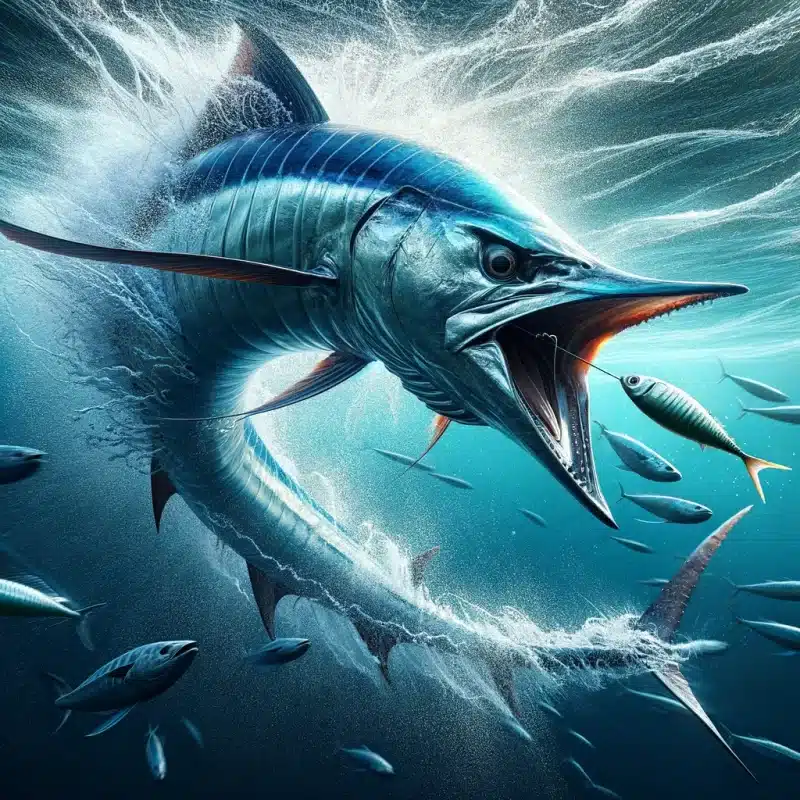Fish Talk, Rigging Talk
The Wahoo’s Bite: A Swift and Violent Encounter
Introduction: In the vast expanse of the ocean, where mysteries abound and creatures of all shapes and sizes roam, there exists a fish renowned for its speed, agility, and surprisingly, its ferocious bite. Meet the wahoo (Acanthocybium solandri), a sleek predator that prowls the tropical and subtropical waters of the world’s oceans. While its streamlined body and lightning-fast movements are awe-inspiring, it’s the wahoo’s bite that truly commands attention, often leaving a lasting impression on those who encounter it.
The Wahoo: A Predator of the Open Seas: The wahoo, often dubbed the “cheetah of the sea,” is a piscine powerhouse known for its incredible speed and agility. With a torpedo-shaped body that slices effortlessly through the water, wahoos are built for swift pursuit and ambush predation. These solitary hunters typically inhabit offshore waters, where they patrol the depths in search of smaller fish, squid, and even smaller prey like flying fish.
Measuring up to 8 feet in length and weighing as much as 180 pounds, wahoos are apex predators in their marine habitats. Equipped with sharp teeth and a voracious appetite, they strike with remarkable precision and force, making them formidable opponents for any creature unfortunate enough to find itself in their crosshairs.
The Anatomy of a Wahoo’s Bite: What sets the wahoo apart from other predators is its jaw structure and bite mechanics. With a mouth full of razor-sharp teeth, including prominent canine-like fangs, the wahoo possesses a formidable arsenal for capturing and dispatching prey. Its jaws are designed to deliver swift, bone-crushing bites, allowing it to incapacitate its victims with astonishing efficiency.
When a wahoo strikes, it employs a lightning-fast burst of speed to close the distance between itself and its target. With jaws agape, it clamps down with tremendous force, often inflicting severe injuries in the process. Victims may find themselves torn apart by the wahoo’s powerful bite, a testament to the sheer strength and precision of this apex predator.
Encounters with Humans: While wahoos typically inhabit deep offshore waters, they occasionally venture closer to shore in pursuit of prey. In some regions, such as the Caribbean and Hawaii, wahoos are prized game fish among anglers for their speed and fighting prowess. However, their aggressive nature and powerful bite mean that handling them requires caution and respect.
Unfortunately, encounters between wahoos and humans can sometimes result in injuries, particularly when fishermen attempt to handle or remove hooks from these powerful fish. In rare cases, swimmers and divers may also fall victim to a wahoo’s bite, especially if they unwittingly provoke or startle the fish.
Conservation and Management: Despite their fearsome reputation, wahoos play a crucial role in maintaining the health and balance of marine ecosystems. As top predators, they help regulate populations of smaller fish and maintain biodiversity within their habitats. However, like many marine species, wahoos face threats from overfishing, habitat loss, and climate change.
To ensure the long-term sustainability of wahoo populations, conservation efforts are underway around the world. Measures such as catch limits, size restrictions, and habitat protection aim to safeguard these iconic predators and the ecosystems they inhabit.
Conclusion: In the vast and dynamic world of the ocean, few creatures command the respect and admiration elicited by the wahoo. From its unparalleled speed and agility to its formidable bite, the wahoo is a true marvel of evolution and a testament to the wonders of marine life. While encounters with this apex predator can be awe-inspiring, they also serve as a reminder of the importance of conservation and responsible stewardship of our oceans. By working together to protect species like the wahoo, we can ensure that future generations will continue to marvel at these magnificent creatures for years to come.

